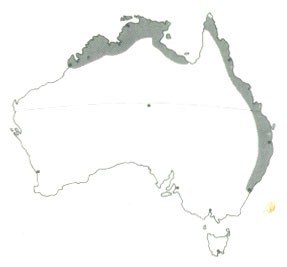![]()
 |
 |
DISTRIBUTION: Common in wetter regions of range. Inhabits rank grasses, reeds fringing rivers, swamps and mangroves. |
Chestnut-breasted Finch |
Distribution Map |
|
IDENTIFICATION. LENGTH = 100 mm ADULTS: Sexes similar. Crown and back of neck grey-brown; back cinnamon-brown; rump, upper tail-coverts and central tail feathers straw-brown; outer tail feathers brown. Face, chin, throat and undertail-coverts black; breast pale chestnut with lower edge bordered black (this band sometimes narrower in female); belly white with flanks barred with black. Eye brown; bill blue-grey; legs leaden-grey. IMMATURES: Olive-brown above; pale buff below with brown-buff breast.
|
NESTING. Breeds all months; mainly summer and autumn. Nest spherical, compressed at sides; 130 mm long, 120 mm high and 90 mm wide; made of dry blades of grass and lined with fine grass stems. Built in dense clumps of grass and reeds, some of which are worked into the outside of the nest. Also bushy shrubs. Eggs: four to six; white; 17 X12 mm.
|
|
FORMS. There is only the one form of Chestnut-breasted Mannikin.
|
|
AVIARY BREEDING. NESTING TYPES: These birds prefer to build their own nest in tall thick grass such as Blady Grass. I have also seen these birds build a nest in a wire mesh tube filled loosely with dry grass. I have never seen these birds use a nest box. FEEDING: A general finch mix is ideal for this bird. Birds will also readily take seeding grasses and live food. However I have had seen these birds breed successfully with just a mixed seed diet. Egg and biscuit will also be taken readily. OTHER FEEDS: Cuttlebone and shell grit should be supplied at all times. SPECIAL REQUIREMENTS: There are no special requirements for this species. However care should be taken not to house this species with the Pictorella Mannikin or the Yellow-rumped Mannikin.
|
| AVIARY SPECIFICATIONS. | WIRE MESH: 1/4 x 1/4 or 6 mm x 6 mm | Also known as mouse wire |
| LENGTH: 11ft 6in or 3575 mm | WIDTH:6ft or 1800 mm | HEIGHT: 8ft or 2400 mm |
| SHED: Half the aviary should be enclosed.
These are recommendations only and individual breeders may have different dimensions and specifications.
|
FLOOR: I have found a dirt floor preferable. |
OTHER: |
|
BREEDER SUBMISSIONS. |
|
| From |
![]()
Author
P Campbell
Copyright © 2002 P. Campbell. All rights reserved.
Revised: April 20, 2002
.